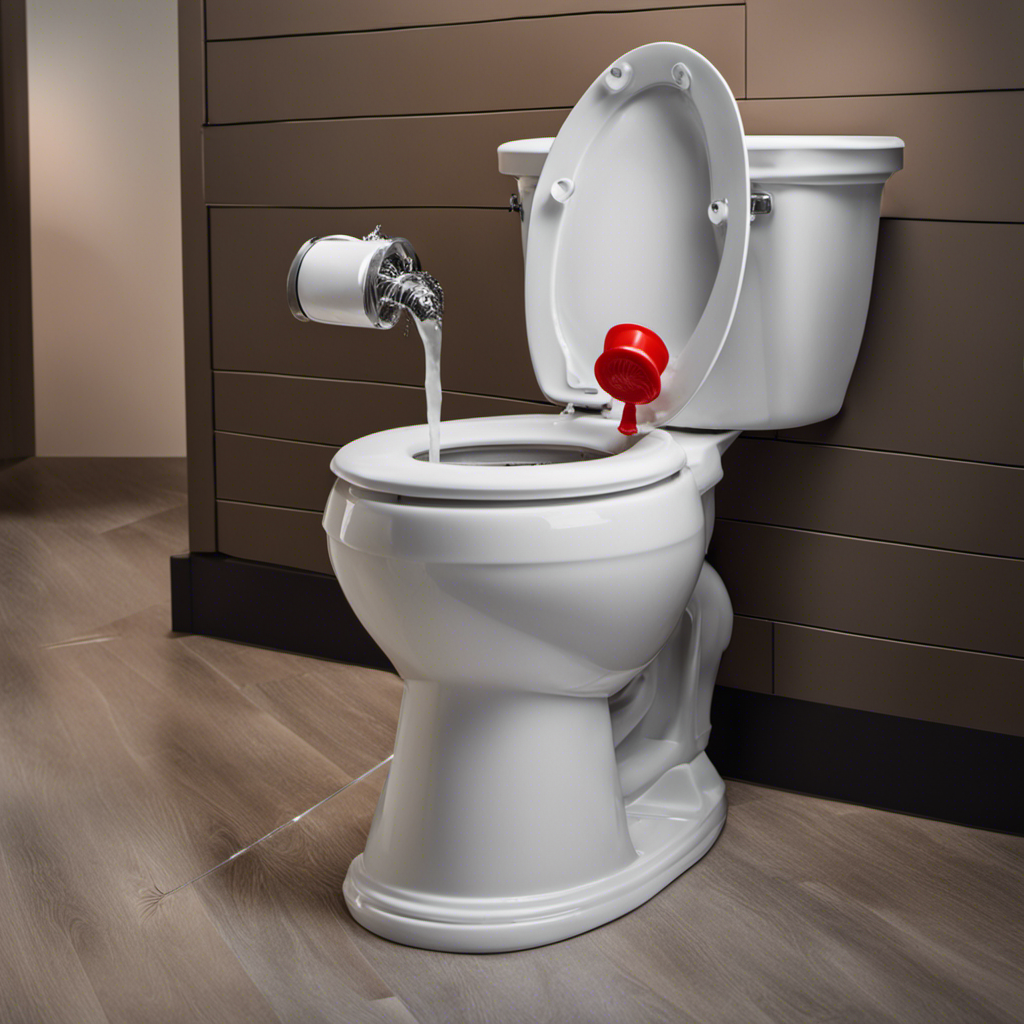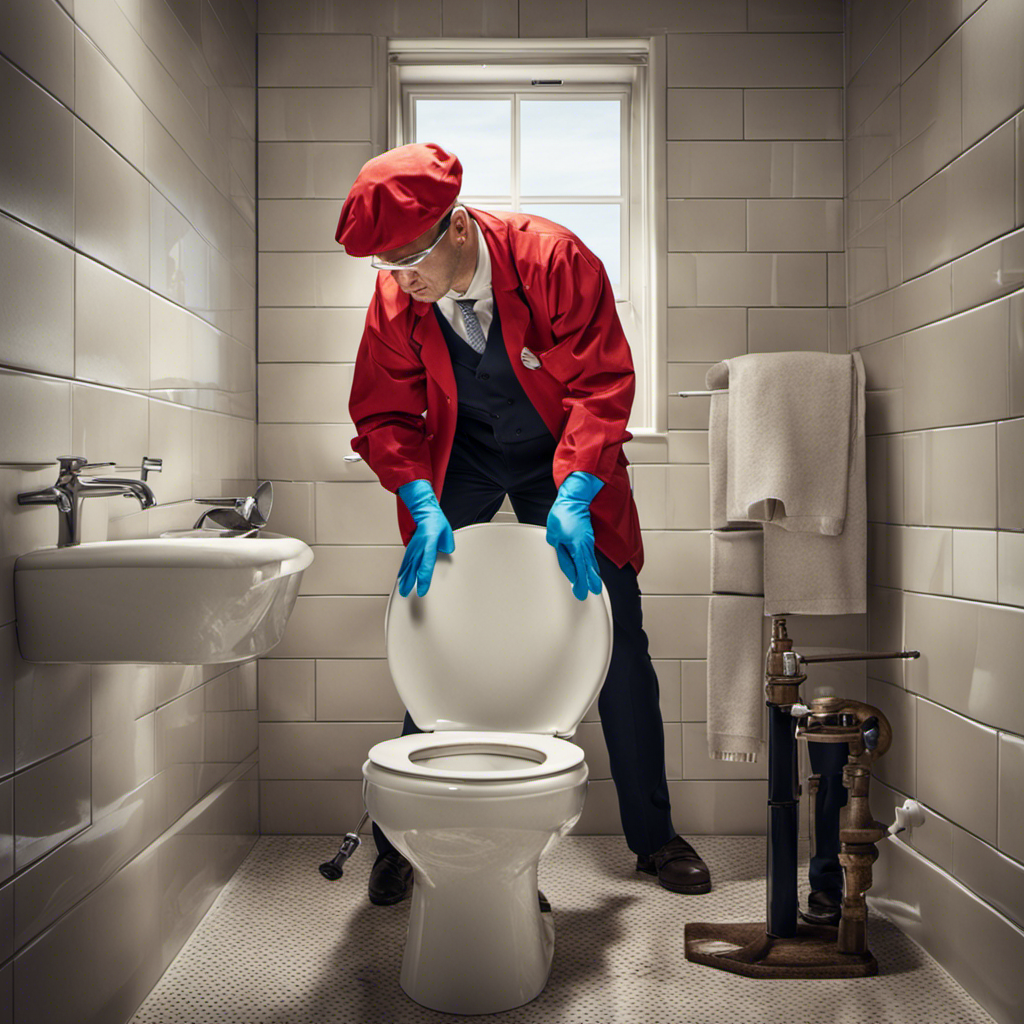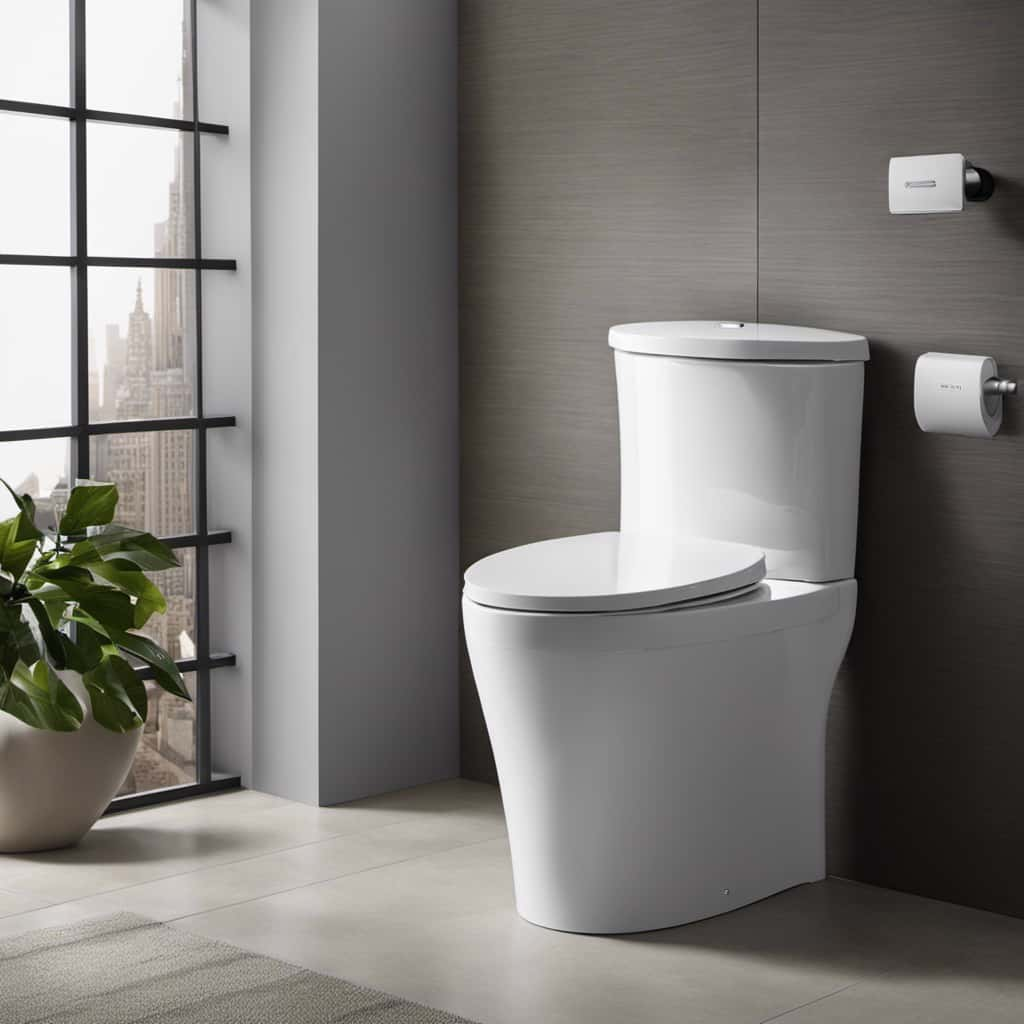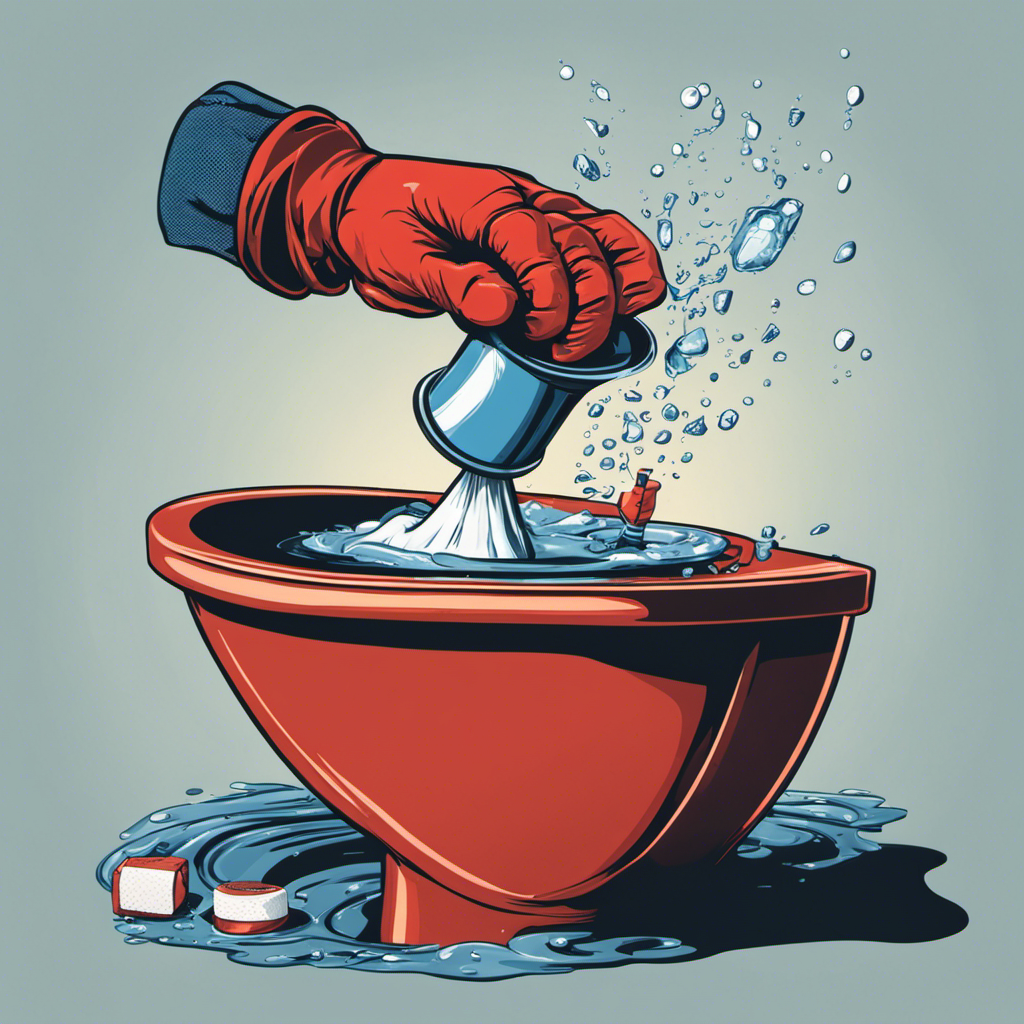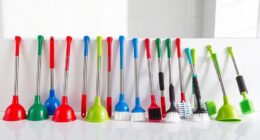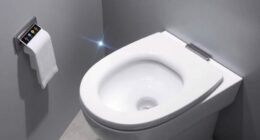I remember the panic I felt when my toilet bowl suddenly clogged, leaving me in a sticky situation. But fear not! With the right tools and a little know-how, you can easily unclog your toilet bowl and restore order to your bathroom.
In this article, I will share step-by-step instructions, using both traditional plunging techniques and natural remedies, to help you tackle even the most stubborn clogs.
So grab your plunger, roll up your sleeves, and let’s get that toilet bowl flowing smoothly again.
Key Takeaways
- Excessive toilet paper usage and flushing non-flushable items can cause toilet bowl clogs.
- Mineral buildup from hard water can also lead to clogs.
- Troubleshoot clogs using a plunger or toilet auger, and consider calling a professional plumber if needed.
- Safety precautions, such as wearing goggles and gloves, should be taken when unclogging a toilet bowl.
Understanding the Causes of Toilet Bowl Clogs
Understanding the causes of toilet bowl clogs can help you prevent future blockages. There are several common causes of clogs in toilet bowls.
One of the main culprits is excessive toilet paper usage. When too much toilet paper is flushed at once, it can easily clog the pipes.
Another cause is flushing non-flushable items such as wet wipes, dental floss, or feminine hygiene products. These items do not break down easily and can quickly create a blockage.
Additionally, mineral buildup can also contribute to clogs. Hard water deposits can accumulate in the pipes over time, reducing the flow and causing blockages.
To troubleshoot clogs, you can try using a plunger or a toilet auger to dislodge the blockage. If these techniques don’t work, it may be necessary to call a professional plumber to resolve the issue.
Essential Tools and Materials for Unclogging a Toilet Bowl
When it comes to unclogging a toilet bowl, there are a few essential tools and materials that I recommend having on hand.
The first decision you’ll need to make is whether to use a plunger or a snake to tackle the clog. Both tools have their advantages and it’s important to choose the one that best suits your situation.
Additionally, it’s crucial to prioritize safety by wearing goggles to protect your eyes from any potential splashes or debris.
Plunger or Snake
To unclog the toilet bowl, grab a plunger or snake and get ready to tackle the blockage. Here are the steps to effectively use a snake technique:
-
Insert the snake: Insert the flexible end of the snake into the toilet drain until you feel resistance. This indicates you have reached the clog.
-
Rotate the snake: Once the snake is inserted, rotate the handle clockwise to break up the blockage. This motion helps the snake navigate through the pipe, dislodging any debris in its path.
-
Remove the snake: Slowly pull out the snake while continuing to rotate the handle. This action helps to catch any lingering debris and ensures a thorough cleaning of the pipe.
If using a snake doesn’t solve the issue, there are alternative solutions you can consider:
-
Hot water and dish soap: Pour a generous amount of dish soap into the toilet bowl, followed by hot water. Let it sit for a few minutes before attempting to flush.
-
Enzyme-based cleaner: These cleaners contain natural enzymes that break down organic waste. Follow the instructions on the product for best results.
-
Call a professional: If all else fails, it may be time to call in the experts. Plumbers have specialized tools and techniques to handle even the most stubborn clogs.
Safety Goggles Necessary
Wearing safety goggles is essential when using a plunger or snake to clear a clog in the toilet. This is because the process of unclogging a toilet can be messy and potentially hazardous. When pressure is applied to dislodge the clog, water and debris may splash back, putting your eyes at risk. Safety goggles provide a protective barrier, preventing any harmful substances from entering your eyes.
Toilet bowl cleaning and maintenance are important tasks to ensure proper hygiene and functionality. Regular cleaning prevents the buildup of bacteria, stains, and odors. It also helps to maintain the efficiency of the toilet’s flushing mechanism. In addition to using safety goggles, it is advisable to wear gloves and protective clothing when performing toilet bowl cleaning tasks. This will further minimize the risk of exposure to harmful substances. By following these safety precautions, you can effectively unclog your toilet while keeping yourself protected.
| Safety Precautions | Importance |
|---|---|
| Wearing Safety Goggles | High |
| Wearing Gloves | Medium |
| Wearing Protective Clothing | Low |
| Using Proper Tools | High |
Liquid Drain Cleaner?
You should consider using liquid drain cleaner as an alternative method for clearing a clog in your plumbing system. While there are other solutions available, such as plungers and plumbing snakes, liquid drain cleaner can be a convenient option.
Here are the pros and cons of using this method:
-
Pros:
- Easy to use: Simply pour the liquid into the drain and let it work its magic.
- Effective: Liquid drain cleaners contain powerful chemicals that can dissolve clogs and clear your pipes.
- Time-saving: Compared to other methods, using liquid drain cleaner can save you time and effort.
-
Cons:
- Harsh chemicals: Some liquid drain cleaners contain corrosive substances that can be harmful to your pipes and the environment.
- Safety precautions: It is essential to follow the instructions carefully and use protective gear to avoid accidents.
- Limited effectiveness: Liquid drain cleaner may not be effective for severe clogs or blockages caused by solid objects.
Considering these pros and cons, it is important to weigh your options and choose the method that suits your specific situation.
Step-by-Step Guide to Plunging a Clogged Toilet Bowl
When it comes to unclogging a toilet bowl, using the correct plunger technique is crucial for success. Knowing how to properly position the plunger, create a tight seal, and apply the right amount of force can make all the difference in effectively clearing the clog.
However, there are common mistakes that should be avoided. These include using too much force, not plunging in a straight up-and-down motion, or neglecting to check the water level before starting.
Correct Plunger Technique
To effectively unclog a toilet bowl, start by positioning the plunger over the drain and ensuring a tight seal. Using the correct plunger technique is crucial to successfully clearing the clog without causing any further damage. Here are some common mistakes to avoid:
-
Insufficient water level: Make sure there is enough water in the bowl to create the necessary suction. If the water level is too low, add some water before plunging.
-
Incorrect plunger placement: The plunger should be centered over the drain, covering it completely. This ensures that the pressure is focused on the clog.
-
Inadequate force: Apply firm and steady pressure while plunging. Push down forcefully, and then pull up sharply to create suction. Repeat this motion several times to dislodge the clog.
Common Mistakes to Avoid
Avoid making common mistakes when using a plunger to clear a clog. It is crucial to understand the proper technique to prevent any damage and ensure the toilet functions efficiently.
First, ensure that the plunger is the correct size for your toilet, with a flange that fits snugly into the drain. Position the plunger straight above the clog and create a tight seal with the bowl.
Maintain a firm grip on the handle and use a quick, forceful motion to push and pull the plunger, generating suction to dislodge the clog. Avoid using excessive force, as it may cause damage to the toilet bowl or pipes.
It is also important to regularly clean and maintain your plunger, ensuring it remains in good working condition for future use.
Using Natural Remedies to Unclog a Toilet Bowl
There are several natural remedies that can be used to unclog a toilet bowl. When faced with a clog, it is important to avoid using harsh chemicals that can damage your plumbing system. Instead, opt for these natural solutions:
-
Hot Water and Dish Soap: Start by pouring a pot of hot water into the toilet bowl. Add a few squirts of dish soap and let it sit for a few minutes. Then, use a plunger to create a strong suction and push the clog through.
-
Baking Soda and Vinegar: Sprinkle a cup of baking soda into the toilet bowl, followed by a cup of vinegar. Let the mixture sit for about 30 minutes, then flush with hot water. The chemical reaction between the baking soda and vinegar will help break down the clog.
-
Enzyme-based Drain Cleaner: Look for a natural drain cleaner that contains enzymes. These enzymes break down organic matter and can help dissolve toilet clogs over time. Follow the instructions on the product label for best results.
Exploring DIY Methods for Clearing Stubborn Toilet Bowl Clogs
If you’re dealing with a stubborn clog in your toilet, try using a plunger to create a strong suction and push the blockage through. This DIY method is often effective and can save you from the hassle and expense of calling professional plumbing services. However, if the plunger doesn’t work or the clog persists, it may be time to consider other DIY alternatives or seek professional help. Here is a comparison table highlighting the pros and cons of DIY methods versus professional plumbing services:
| DIY Alternatives | Professional Plumbing Services |
|---|---|
| Affordable | Can be costly |
| Requires time and effort | Quick and efficient |
| May not solve complex issues | Can handle any plumbing problem |
| Risk of causing further damage | Trained and experienced professionals |
In some cases, simple DIY methods may be sufficient to unclog your toilet bowl. However, if the clog is persistent or if you’re unsure about how to proceed, it’s always best to consult a professional plumber to avoid potential complications or damage to your plumbing system.
Preventive Measures to Maintain a Clog-Free Toilet Bowl
To keep your toilet free from clogs, regularly maintain it by flushing only appropriate materials and avoiding excessive toilet paper usage. Here are three preventive measures you can take to ensure a clog-free toilet bowl:
-
Use a plunger: Keep a plunger handy in your bathroom to quickly and effectively clear minor blockages. Make sure to use a toilet plunger specifically designed for toilet bowls.
-
Install a drain screen: Placing a drain screen over your toilet drain can catch hair, debris, and other small objects, preventing them from entering the plumbing system and causing blockages.
-
Conduct routine inspections: Regularly inspect your toilet bowl and flush valve for any signs of damage or wear. Replace faulty parts promptly to prevent future blockages.
Frequently Asked Questions
Can a Toilet Bowl Clog Be Caused by Flushing Excessive Amounts of Toilet Paper?
Yes, excessive toilet paper usage can cause toilet bowl clogs. When flushed in large amounts, toilet paper can accumulate and create blockages in the plumbing system, leading to clogs that require unclogging.
What Should I Do if Plunging Doesn’t Unclog My Toilet Bowl?
When plunging won’t solve the problem, don’t panic! There are alternative solutions to unclog your toilet bowl. If all else fails, it’s time to call in the professionals for their expert plumbing services.
Are There Any Specific Natural Remedies That Are Particularly Effective for Unclogging a Toilet Bowl?
Natural remedies such as vinegar and baking soda can be particularly effective for unclogging a toilet bowl. They act as a powerful combination, breaking down the clog and allowing it to be flushed away easily.
Can Using a Toilet Bowl Cleaner Regularly Help Prevent Clogs?
Certainly! Using a toilet bowl cleaner regularly can effectively prevent clogs. However, it’s also wise to explore alternative preventative measures such as proper waste disposal and regular maintenance to ensure a trouble-free toilet.
Are There Any DIY Methods for Unclogging a Toilet Bowl That Should Be Avoided?
There are DIY methods for unclogging a toilet bowl that should be avoided. These can include using harsh chemicals or objects that may damage the plumbing system. It’s best to rely on professional plumbing services for effective and safe unclogging.
Conclusion
In conclusion, unclogging a toilet bowl can be a messy and frustrating task. However, with the right tools and techniques, it can be accomplished successfully.
Just like how we tackle clogs in our lives, it requires patience, determination, and the willingness to get our hands dirty.
Remember, prevention is key to maintaining a clog-free toilet bowl, so make sure to practice good habits and avoid flushing anything that could cause a blockage.
By taking these preventive measures, you can ensure a smoothly flowing toilet bowl and a hassle-free bathroom experience.
